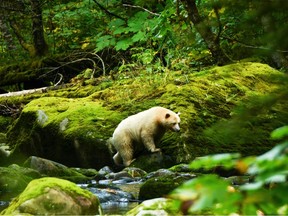
Reviews and recommendations are unbiased and products are independently selected. Postmedia may earn an affiliate commission from purchases made through links on this page.
Expedition leader Philip Stone appeals for calm aboard the ship, flattening his palms downward to quell the mutinous after-dinner, wine-fuelled demand for bears. Bears, bears, bears, now!
Early into Maple Leaf Adventure’s Great Bear Rainforest, a Canadian Geographic, eight-day photography exploration of B.C.’s north and central coast, the 22 guests’ calls for action rise into gales of laughter before lapsing into a squinty, bring-us-the-bears show of solidarity.
So far, the search for bears has been a bust.
It’s all in good fun but if Stone, caught in the crosshairs of wildlife-hunting amateur photographers loaded up on vino, slept in his berth with a knife between his teeth, who could blame him?
“Environmental science is a contact sport,” says John Smol, the trip’s onboard Canadian Geographic Ambassador and one of the world’s top environmental researchers. He was referring to salmon trying to survive pollution and climate change but hey, it fit. “Things can get really messy, real fast.

The bears are the showstoppers on this tour aboard the Cascadia, a 42-metre luxuriously outfitted, expeditionary catamaran that probes the wildest reaches of the coast with its two smaller, nimble boats. As we will discover, bears can’t be reliably scheduled. Even so, Stone, newly crowned bear impresario, is under pressure to deliver.
The elusive white-and-cream Kermode, otherwise known as the Spirit Bear and the Dream Bear, is the most prized target, though black and grizzly bears will do. It’s autumn and the salmon run, primed for bear feeding season in autumn, is accelerating.
With onboard naturalist Ethan Browne, we are exploring by sea and foot the Great Bear Rainforest, which ranges over 6.4 million hectares along the coast. It teems with wildlife and old-growth forest, waterfalls, estuaries and inlets, uncharted islands, fjords sliced by glaciers, and, in autumn, the salmon struggling upstream to spawn before taking their last gasps.

Along with the humpback whales, seals, otters, eagles, white-winger scoters, red-necked grebes, and black oystercatchers that we saw and heard (36 birds, many trees, 11 mammals and a few howling coastal wolves), there were emphatic spells of silence.
Bear watching, we learned, must be earned.
As we glided into Kiltuish Inlet, I lowered my head and made little coughs, throat dry, trying not to scare away potential wildlife. I slipped a candy out, hoping that the tiny sound of the tinfoil wouldn’t make a ruckus. I was sweating profusely. I wondered if my last thought would be, as I was being savoured to death by swarming black flies, did my tears taste like gravy?
The sustainably managed, wild-caught, location-sourced sockeye salmon that Cascadia head chef and fellow Calgarian Christopher Picek had prepared for our dinner made me even more delectable. Retracting my hands into my sleeves, I watched an exhausted salmon float past, rolling over in the water, again and again, to reveal a final, bald-eyed gawk at the sky.
So, no bears this outing, but a later reward awaited in Chief Mathews Bay: the amniotic lull of sleeping on a boat, the up and down floaty feel of being suspended between two mountains, anchored for the night with your inner compass slowly wheeling round to its natural set point.
The next day, during an early morning kayak ride, watching the sun scrape the tops of mountains, the drip and plonk of the paddle soon collapsing into an agreeable silence, I realized that the pursuit of bear watching is a boot camp for stillness.
In the afternoon, taking the Gardner Canal to Europa Bay, we knew that somewhere, bears prowl the edge of waters to scoop up the leaping salmon, biting off the heads before casting the remains for late-to-the-party scavengers as white gulls squawk and wheel on high.

Paydirt. On the shoreline, there was a grizzly bear, a great, shaggy sheet of brown muscled fur, cavorting along mossy rocks and fallen trees, digging in the mouth of a creek. It saw us and ambled away. We went afterwards to the shore and into the trees, the smell of rotting salmon rising from the forest.
When I briefly trundled away to try and get a better look at the creek, the excellent crew kept us safe, mostly from ourselves. This is why it is so important to have experienced guides, especially in bear country. The thrill of being so close to bears with an expedition leader meant that we were not dispatched as afternoon snacks.
Again, we waited, and again, the bugs. I was practicing Zen-like detachment, but the bugs attached themselves with unshakable zest. After an hour of stoic silence, playing the waiting game that is a necessary part of bear-watching, we fled.
Days later, at Gribbell Island, we spent diligent hours at a bear viewing camp, which featured raised and sheltered platforms at a fecund creek, resulting in a memorable payoff. A black bear and a Spirit bear appeared on cue, as if Stone had finally, miraculously, booked them for the main event. Delighted, camera clicks erupted like fireworks.

There is a delicate balance between extracting resources that feed the economy and protecting natural wonders such as the Great Bear Rainforest.
In his final remarks to us, Stone said: “We’re passionate about working here, and as magical the experience is that we’ve had, this place is at risk. We must advocate for protecting it. We can’t imagine it will be like this forever.”
We have the power to be consequential. We can also be reverential and remind ourselves that once it’s gone, that’s it. The dream of the Spirit Bear, considered by some to be a supernatural being and messenger, may yet haunt us.
